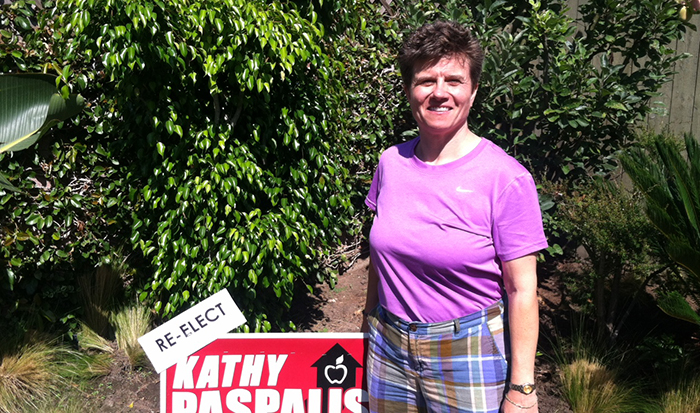Re: “Why Do We Get Along So Well?”
[Editor’s Note: Resuming his For Great Schools series, Scott McVarish, co-founder of the United Parents of Culver City, interviews School Board member Kathy Paspalis. On the Board for 5 ½ years, she has two children who are coming into their junior year at the high school. They were at the Culver City Middle School and at El Marino prior to that. Today’s subject is Language Immersion at the Secondary Schools.. See www.facebook.com/forgreatschools]
Mr. McVarish: Here is an issue about staffing. You can’t have laboratories, whether they be science or culinary, without the proper staff. The same is true with the language program. Kids start at La Ballona and El Marino learning Spanish, or Japanese at El Marino. First it was just elementary. Then you pushed hard to expand it to the Middle School. Now it stops at eighth grade. I have heard you ask the question, “What good is an eighth grade fluency?”
Ms. Paspalis: My old mantra was, “What good is fifth grade fluency in any language?” My new mantra became, “What good is eighth grade fluency in any language?” We keep working on improving the program. It is a staffing issue, and it’s also a curriculum issue. We had to find a teacher with the right credential to be able to teach in Spanish. We also teach the single subject of social studies. Once we found someone — and now we have two of them — we could expand that program. While staffing is one issue, curriculum is another. The other option that we opened up even before we really started that second-class option again, was to have the zero period at 7:15 when they take P.E. That was opened up, not just to immersion kids, but to any kid who was in a particular kind of program or who wanted to take what appears on a schedule as two electives. Those kids can do Spanish and they can do band. They can do remedial math and they can do choir. We tried to go for a period seven rather than a period zero but there are just too many afternoon activities to make that a viable option.
Mr. McVarish: Is this a problem that the School District is actively seeking to solve? Or are you championing it and hoping you will eventually get support?
Ms. Paspalis: It’s being worked on at the high school level. The high school master schedule is different than what happens at the Middle School. There is a set curriculum such as the A’s through G’s for University of California qualification and just the qualifications that the kids need to simply graduate. Where do we plug it in? And how many kids will take it? Now that we have, at least on the Spanish side, kids matriculating from both La Ballona and El Marino into the Middle School, that same first cohort of kids will be matriculating into the high school. I hope by then we will have a solid plan at the high school for additional classes beyond Spanish 1, 2, 3, Advanced Placement Spanish, and AP Spanish literature. Then for the incoming immersion kids, it would be Nativos 2, Nativos 3. At that point, those kids who actually are native speakers, can also jump in. They can jump in at the sixth grade point if they’re not at La Ballona or El Marino, They can also jump in at ninth grade, which is a great opportunity for them to become bi-literate in a language that they may carry with them their entire lives.
Mr. McVarish: How about the Japanese program?
Ms. Paspalis: The Japanese program is another kind of work-in-progress. One of the things I have been pushing for is that the I-Academy provides some options. We are looking into that. I believe we may be presenting options for the Advanced Placement class. That is kind of the capstone of the whole program. The child has invested 11 years, 12 years in that program. To be able to get college credit is an important opportunity for them. We have some scheduling conflicts so the I-Academy will provide that opportunity this year.
Mr. McVarish: Can you explain to our readers the I-Academy?
Ms. Paspalis: The I-Academy is our online academy. There are rural districts in this country where kids don’t have AP physics, or similar classes. How do they get them? The opportunity for those credits is opening doors in many different places. We wanted to bring that same opportunity to Culver City. Some kids want that opportunity period. They can choose to go to our I-Academy. They can enroll there and they can get their classes from the I-Academy. I see it, though, as a way to enhance our Spanish and especially our Japanese programs. Initially there are only two kindergartens on the Japanese side. By the time those kids matriculate to the Middle School, the number keeps lowering. When they get to the high school, are they going to continue? That number diminishes every year. There is nobody adding into the program. How do we justify the staffing?
Mr. McVarish: Perhaps if we offered classes in Japanese, such as social studies at the high school, it might recruit people into Culver City. Not many other districts are offering that at the high school level.
Ms. Paspalis: We have high school classes in Japanese — Japanese 1, 2, and Advanced Placement. But there aren’t enough kids to fill seats for a social studies course in Japanese.

